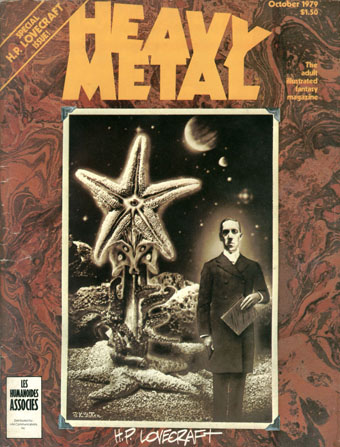
Mr Lovecraft by JK Potter.
HP Lovecraft died seventy-five years ago on 15th March, 1937. Twenty-five years ago I was halfway through drawing my comic strip adaptation of The Call of Cthulhu, conscious at the time that, yes, it was fifty years ago today… I mentioned at the weekend the special Lovecraft edition of Heavy Metal that was published in October 1979; of the many stimuli that led to the drawing of CoC, this magazine was by far the most important. Given the date, now seems as good a time as any to say something about it.
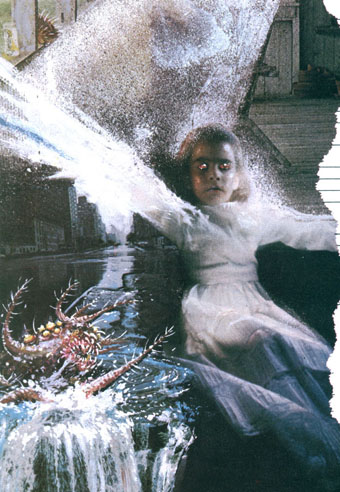
Illustration for the contents page by Stephen R. Bissette.
Heavy Metal was the US offshoot of Métal Hurlant, the sf/fantasy comics magazine founded by Jean Giraud (Moebius), Philippe Druillet and Jean-Pierre Dionnet in 1974. Copies of Métal Hurlant could be found in London but none ever made it further north. The advent of Heavy Metal provided an invaluable introduction to a generation of European artists whose work was otherwise difficult to find. Even better: their stories were being translated into English for the first time. The late 70s was a dizzying period for a Lovecraft reader: HR Giger appeared apparently out of nowhere in 1977 when Big O published the first UK collection of his art (which I couldn’t afford at the time), a book with Necronomicon in the title; a year later Thames & Hudson published Franz Rottensteiner‘s The Fantasy Book, an overview of the genre that devoted eight pages to Lovecraft and Arkham House, and which included many illustrations I’d never seen before; in 1979 Giger was all over the newspapers and magazines thanks to Alien; then in October the Lovecraft special dropped onto the shelves. I was stunned: this was that rare occasion when someone creates exactly the thing you want to see at precisely the right moment.
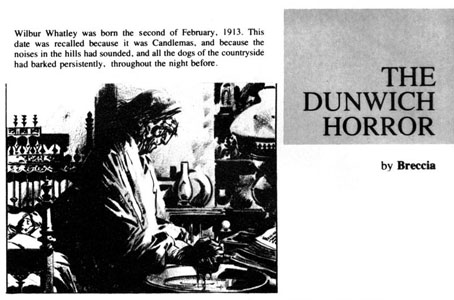
The Dunwich Horror by Alberto Breccia. A superb adaptation.
Looking back, the issue isn’t quite as good as it seemed at the time: many of the stories are slight, a couple have nothing whatever to do with Lovecraft, and, Breccia aside, none of the artists tackle the major works. What counted in the end was the idea of the issue, the implication that Lovecraft’s imagery was there to be seized and reworked in visual form. There were better issues of the magazine, before and after, but for the next six years this one remained for me a tantalising possibility. They hadn’t got it quite right…what if someone else did? After searching comic shop shelves in vain I eventually decided to have a go myself.
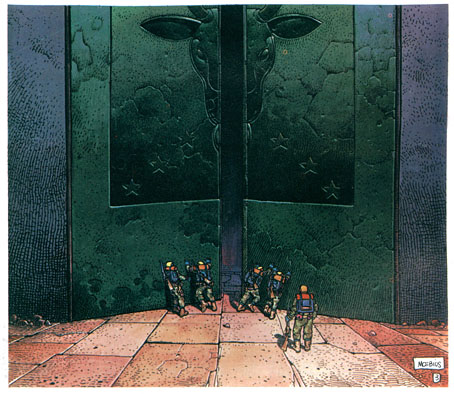
Ktulu by Moebius. A silly piece but those doors are nice.
The connections didn’t end with the influence on my own work. Years later, Steve Bissette, the artist responsible for that curious illustration above, got in touch wanting to publish my adaptation of The Call of Cthulhu in a Lovecraft comics collection he was putting together for Kevin Eastman’s Tundra Publishing. This was one of the first things Tundra had planned but its production was thwarted by the collapse of the company who overstretched themselves while the book was in preparation. JK Potter’s Lovecraft portrait and Breccia’s Dunwich would have been included, together with many other pieces. As it happens Kevin Eastman is the current owner of Heavy Metal.
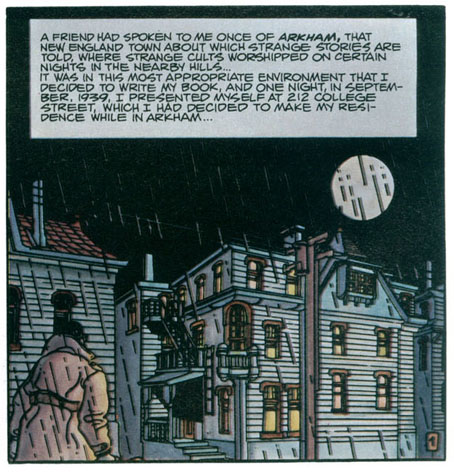
Serge Clerc, an artist not known for horror, ventures into Lovecraft territory.
A couple of years later I met Lou Stathis who was then an editor at DC Comics but who I knew mainly for the music columns he began writing for Heavy Metal in 1980. Lou was looking out for artists who weren’t doing the usual superhero stuff, and was very enthusiastic about my Lovecraft art. (He also asked what drugs I used. “Earl Grey tea,” was the reply.) In the end DC remained unconvinced that any of my work belonged in their pages so we went our separate ways. I wish we’d stayed in touch: he was good company and interested in a lot more than just comics. He died in 1997 of a brain tumour. RIP Lou, and thanks for taking an interest.
A few more page samples follow.
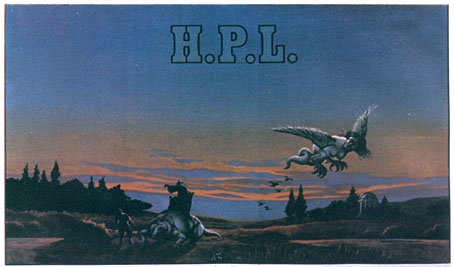
HPL by Jean-Michel Nicollet. Very similar to the Moebius piece—both feature Lovecraft himself as a character.
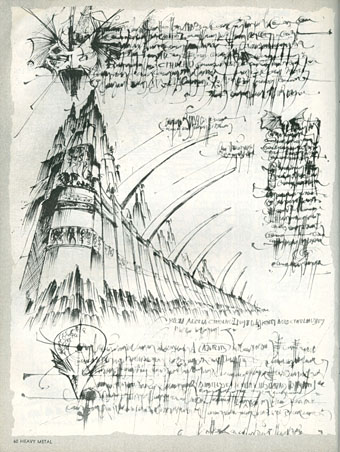
Excerpts From The Necronomicon by Philippe Druillet.
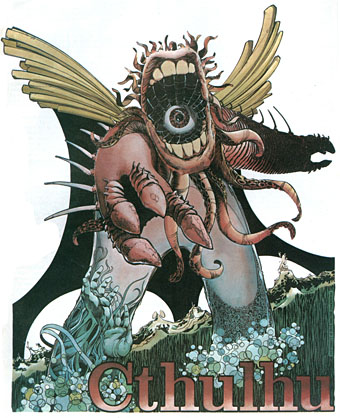
Cthulhu by Walt Simonson. An illustration for The Alchemist’s Notebook, described as an extract from a novelization of a forthcoming feature film, The Cry of Cthulhu.
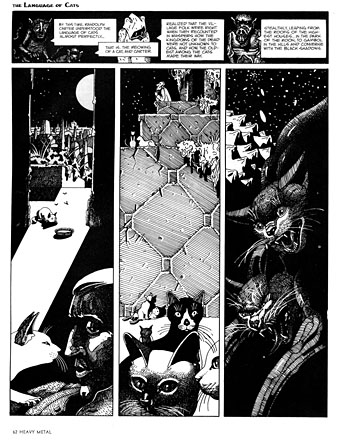
The Language of Cats by Nicole Claveloux. A Dreamland piece about Lovecraft’s favourite animal.
Elsewhere on { feuilleton }
• The Lovecraft archive

Franz Rottensteiner‘s The Fantasy Book: Haven’t had that out of the shelves for a while. Some very nice pictures, if the text is a bit ‘beginners level’. Have you seen The Science Fiction Book?
The text never struck me as particularly beginners level, I think he did a good job of introducing a very sprawling medium. He’s also a lot more wide-ranging than many other studies of the genre, even now. That book was the first place I came across mention of Stefan Grabinski, for example.
I have seen the science fiction book but never bought it: a lot of the sf after Wells and up to New Worlds doesn’t interest me at all. There also seemed to be a lot more of those kind of books around, filled with robots and spacecraft. Rottensteiner’s fantasy book was far more of a one-off in that respect.
Alberto Breccia produced a series of black and white Lovecraft adaptations to the same high standard as his Dunwich Horror, collected in one volume as Mythes De Cthulhu. It’s a shame that this doesn’t seem to have been translated into English.
There was also a parallel Metal Hurlant HPL special, with slightly different contents.
Soukesian: Yes, as I later discovered although I’ve not seen much of Breccia’s other work. I’ve never seen the French magazine either, always wondered what it contained in place of the American strips.
‘JK Potter’!!! Too good to be true!